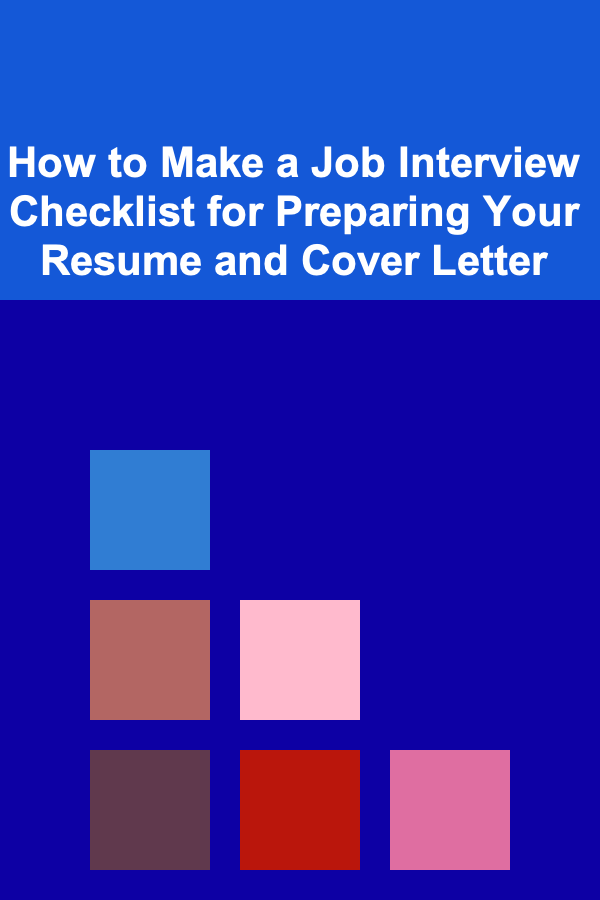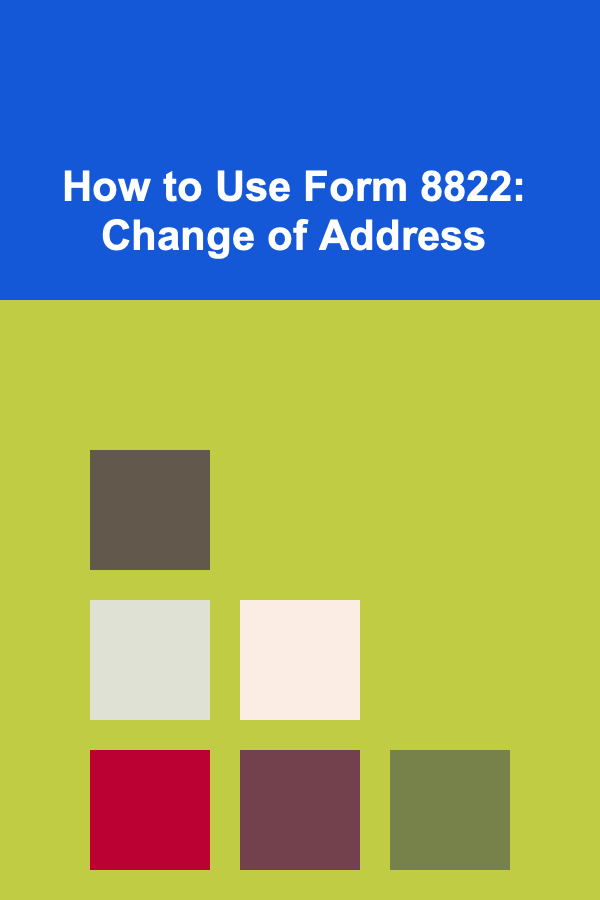
How to Make a Job Interview Checklist for Preparing Your Resume and Cover Letter
ebook include PDF & Audio bundle (Micro Guide)
$12.99$5.99
Limited Time Offer! Order within the next:

Preparing for a job interview can be overwhelming, especially if it's your first time applying for a position in a competitive field. However, the key to acing an interview starts well before you step into the room or log on to the virtual meeting. One of the most important aspects of your preparation is ensuring that your resume and cover letter are tailored to the specific job and company you're applying to. These documents are often the first impression you make on potential employers, so it's essential to get them right.
In this actionable guide, we'll walk you through how to create an effective job interview checklist focused on preparing your resume and cover letter. Following these steps will not only improve your chances of landing an interview but also make sure you're fully prepared when it's time to meet with the hiring manager.
Step 1: Understand the Job Description
Before you do anything, thoroughly read the job description. The job description is your blueprint for tailoring both your resume and cover letter. This is where you'll find the specific qualifications, skills, and experiences that the company values most.
Key Actions:
- Identify Key Skills and Qualifications: Highlight any skills or qualifications listed in the job description that are required or preferred. These will be the core competencies you need to emphasize in your documents.
- Understand Company Values and Culture: If the job description includes insights about company culture or values, take note of these. Companies often look for candidates who align with their mission, so incorporating relevant keywords and values into your application can give you an edge.
- Analyze the Job Requirements: Break down the job duties and see how your past experience aligns with them. Note specific accomplishments or projects that directly relate to the tasks you'll be expected to perform.
Step 2: Tailor Your Resume for the Job
Once you have a clear understanding of the job description, it's time to start tailoring your resume. Generic resumes rarely stand out in today's job market. A resume that's specifically crafted for the job you're applying for shows that you're a serious candidate who is genuinely interested in the position.
Key Actions:
-
Choose the Right Resume Format: The three most common resume formats are chronological, functional, and combination (hybrid). Choose the one that best showcases your experience and achievements based on the job you're applying for.
- Chronological: Best if you have a solid work history with no significant gaps.
- Functional: Ideal if you're changing careers or have limited work experience.
- Combination: Works well if you have both strong skills and work experience you want to highlight.
-
Highlight Relevant Skills: Use the key skills you identified from the job description to update your resume's skills section. Be specific about your abilities and how they align with the job.
Example: If the job requires "project management skills," and you have experience managing projects, include that in both the skills section and your job history.
-
Quantify Achievements: Whenever possible, include numbers or specific examples to showcase your achievements. This helps the hiring manager see the tangible impact you've had in previous roles.
Example: "Led a team of 5 in developing a marketing strategy that resulted in a 25% increase in customer engagement."
-
Tailor Your Experience: Highlight work experience that directly relates to the job. If your resume includes work that's not relevant, consider omitting it or placing it lower down on the page.
-
Use Action Verbs: Start each bullet point with a strong action verb to demonstrate your contributions and skills. Words like "managed," "developed," "increased," and "improved" convey your impact clearly and effectively.
-
Remove Irrelevant Information: Ensure your resume is concise and to the point. Remove anything outdated or irrelevant, such as hobbies or experience that doesn't add value to the position you're applying for.
Step 3: Customize Your Cover Letter
Your cover letter should complement your resume by providing additional context and demonstrating your enthusiasm for the position. A well-crafted cover letter can make you stand out from other applicants, even if your resume is a great match for the role.
Key Actions:
-
Personalize the Salutation: Address your cover letter to the hiring manager by name, if possible. A personalized greeting helps create a connection and shows that you've done your research. If you can't find the name, use a generic but respectful greeting like "Dear Hiring Manager."
-
Start Strong with a Hook: The first paragraph should immediately grab the reader's attention. Briefly explain why you're interested in the role and why you're a perfect fit for the company. If you have a mutual connection or any unique qualification, mention it early to establish credibility.
-
Highlight Key Achievements: Use the body of your cover letter to expand on the experience and skills listed in your resume. Focus on two or three key achievements or experiences that align with the job description.
Example: "In my previous role at XYZ Corp, I successfully led a team that streamlined our customer support process, resulting in a 30% reduction in response time."
-
Demonstrate Cultural Fit: Reference any company values or cultural aspects mentioned in the job description and explain why they resonate with you. Hiring managers want to know that you will thrive within their team and contribute positively to the company culture.
-
Be Concise and Specific: Keep your cover letter to one page. Hiring managers often have limited time, so avoid overly long paragraphs and irrelevant information.
-
Express Enthusiasm: Show that you're genuinely excited about the opportunity to work with the company. A positive attitude and enthusiasm can make a significant impact on how your application is perceived.
-
Conclude with a Call to Action: End your cover letter by expressing your interest in discussing the position further. Invite the hiring manager to contact you for an interview and thank them for considering your application.
Step 4: Proofread and Edit Your Documents
Before submitting your resume and cover letter, proofreading is critical. Even a small error can leave a negative impression on a hiring manager.
Key Actions:
- Check for Typos and Grammar Errors: Read your resume and cover letter carefully to ensure there are no spelling or grammar mistakes. Even minor issues can make you appear careless.
- Ensure Consistency: Make sure that the formatting of both documents is consistent. Fonts, sizes, and spacing should be uniform, and headings should be styled consistently throughout.
- Ask for Feedback: Have a trusted friend, family member, or mentor read over your resume and cover letter. Sometimes, a fresh set of eyes can catch mistakes that you might have missed.
- Use Online Tools: Utilize online grammar and spelling checkers, such as Grammarly or Hemingway, to further polish your documents. These tools can help ensure that your writing is clear, concise, and free from errors.
Step 5: Save Your Documents in the Right Format
Once you've finalized your resume and cover letter, ensure that they are saved in the correct format. Most employers prefer receiving documents in PDF format, as it ensures the formatting remains consistent regardless of the device or software the hiring manager uses.
Key Actions:
- Save as PDF: Saving your documents as PDFs helps ensure that they look professional and maintain their formatting.
- Label Your Files Appropriately: Name your files clearly so that the hiring manager can easily identify them. For example, use "JohnDoe_Resume.pdf" and "JohnDoe_CoverLetter.pdf."
- Check File Size: If you're submitting your application via email, make sure that the file size is within the limits specified by the company. Most employers prefer files under 2MB to ensure they can be easily opened.
Step 6: Submit Your Application
Once your resume and cover letter are polished and ready, it's time to submit them. Carefully follow the submission instructions provided in the job posting.
Key Actions:
- Follow Instructions: Ensure that you're submitting your documents in the correct format and through the correct channel. If the employer requests that you apply via their website, do so.
- Double-Check Everything: Before clicking "submit," review your application to make sure that all the necessary documents are attached, and all fields are filled out correctly.
Conclusion
Creating a job interview checklist for preparing your resume and cover letter is an essential step in securing a job interview. By thoroughly understanding the job description, tailoring your resume and cover letter, proofreading your documents, and following submission instructions, you increase your chances of catching the hiring manager's eye. A well-prepared application not only showcases your qualifications but also demonstrates your professionalism and attention to detail. So take the time to follow each step carefully, and set yourself up for success in the job search process.
Reading More From Our Other Websites
- [Home Rental Property 101] How to Set the Right Rent Price for Your Property in a Competitive Market
- [Personal Financial Planning 101] How to Make Your Money Work for You Through Passive Income
- [Home Budget 101] How to Create a Weekly Budget That Fits Your Lifestyle
- [Home Renovating 101] How to Plan for Proper Ventilation in Your Home Renovation
- [Biking 101] Cycling Training for Performance: How to Push Your Limits
- [Home Holiday Decoration 101] How to Create a Stunning Holiday Centerpiece for Your Dining Table
- [Organization Tip 101] How to Use Labels for Easy Identification of Items
- [Personal Investment 101] How to Invest in the Stock Market: A Beginner's Roadmap
- [Home Budget Decorating 101] How to Decorate Your Home with Affordable Wall Mirrors
- [Personal Investment 101] How to Make Your First Real Estate Investment with Little Money

How to Implement a "One In, One Out" Rule for Seasonal Wardrobe Changes
Read More
How to Maximize Closet Space with Smart Organizing Techniques
Read More
How To Understand Intellectual Property for Small Business Owners
Read More
How to Manage Cravings for Sustainable Weight Loss
Read More
How to Identify Crossword Themes Quickly
Read More
How to Use Form 8822: Change of Address
Read MoreOther Products

How to Implement a "One In, One Out" Rule for Seasonal Wardrobe Changes
Read More
How to Maximize Closet Space with Smart Organizing Techniques
Read More
How To Understand Intellectual Property for Small Business Owners
Read More
How to Manage Cravings for Sustainable Weight Loss
Read More
How to Identify Crossword Themes Quickly
Read More